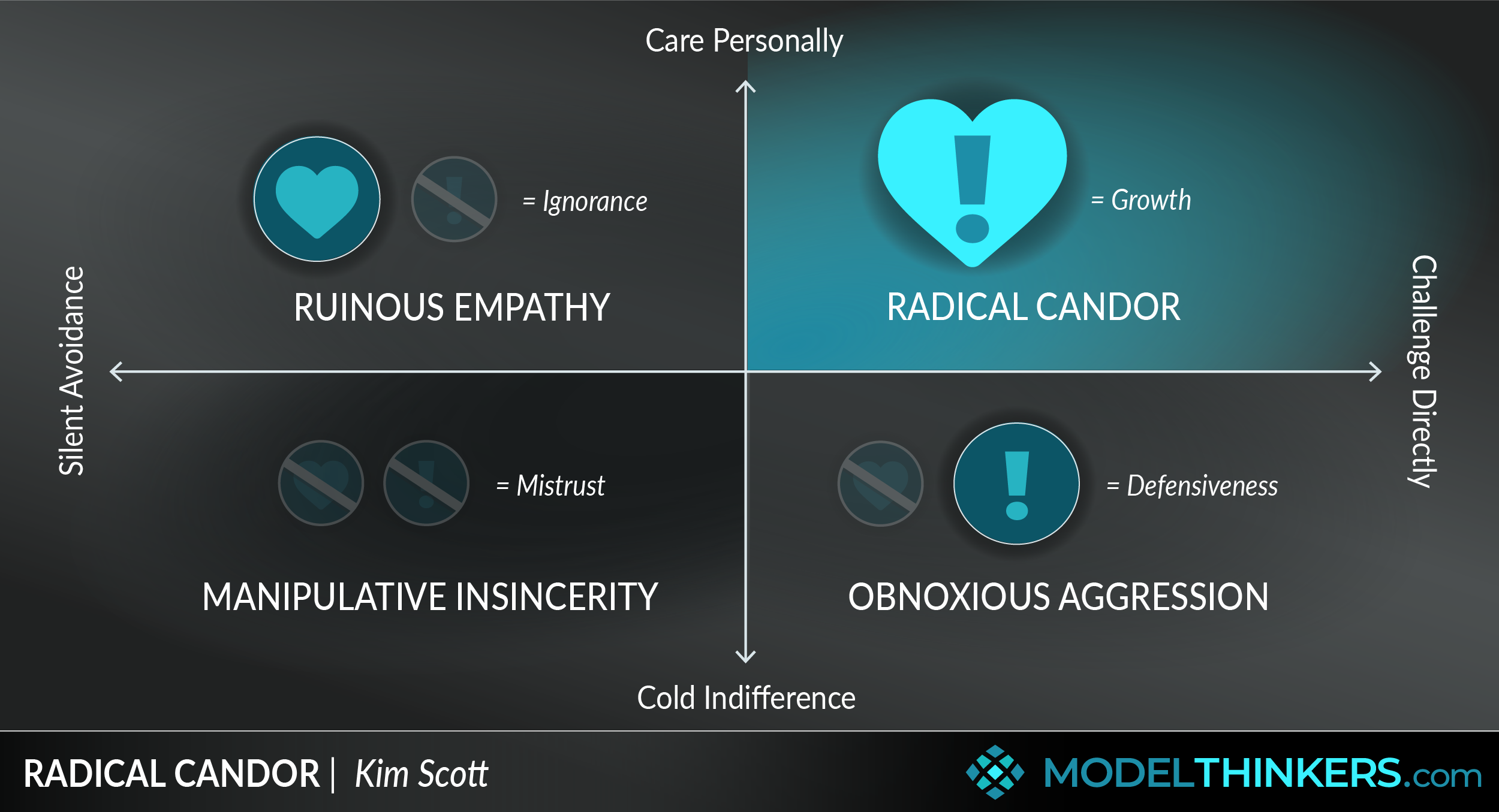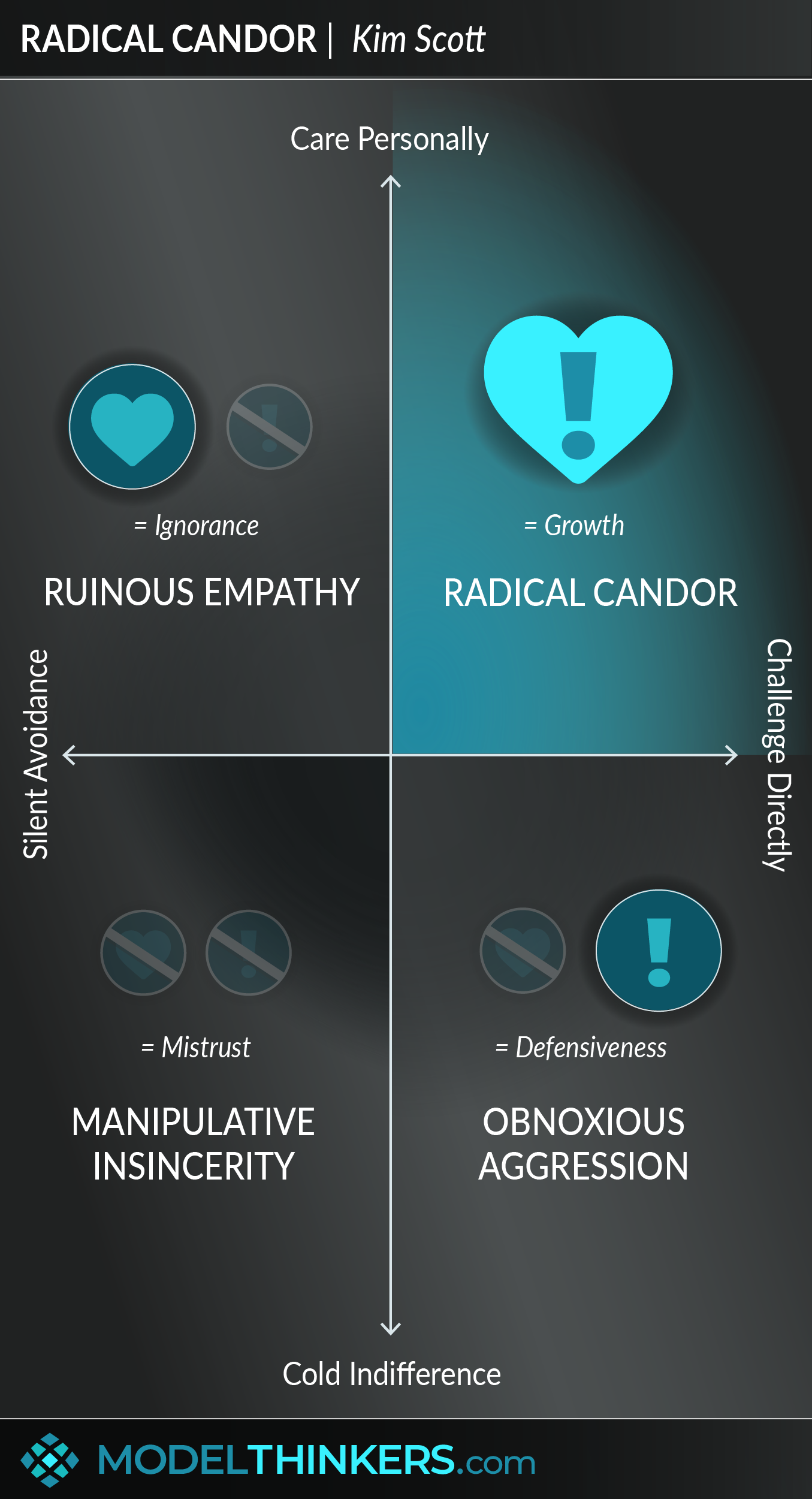

 0 saved
0 saved
 31.1K views
31.1K views








‘If you don’t have anything nice to say, don’t say anything at all.’ That message was likely ground into you throughout your childhood. At the same time, you don't have to look far to find examples of obnoxious feedback under the guise of being ‘brutally honest.’
Fortunately, you don’t just have to choose between polite silence or rude honesty.
Radical Candor is the ability to simultaneously challenge directly and show that you care personally.
GIVE A DAMN, PISS PEOPLE OFF.
Kim Scott’s Radical Candor Framework encourages you to ‘give a damn’ for the people around you, and constructively speak the truth, even when it pisses people off. It’s essentially a call to action to be both caring and direct by combining bluntness with empathy.
Helped by the model’s compelling origin story from the corridors of Google (see In Practice below for Scott’s story), the model has become popular in big tech and agile organisations as a means to enable high-performing teams and a culture of feedback.
THE FRAMEWORK.
The quadrants of the Radical Candor Framework are mapped on two axes:
-
the ‘care personally’, or the ‘give a damn dimension’ versus
-
the ‘challenge directly’, or the ‘willing to piss people off dimension.’
In addition to the sought after Radical Candor quadrant, the three remaining quadrants are:
-
Obnoxious Aggression. The quadrant of high challenge but low care. It’s that place of ‘brutal honesty’ generally resulting in praise that doesn’t feel sincere or meaningful, and criticism delivered rudely or insensitively. Let’s face it, this is the ‘jerk zone.’
-
Ruinous Empathy. The quadrant where you can be ‘nice’ in the moment, but undermining in the long run. You care, but you’re staying silent because you’re worried about the impact of challenging the person you want to help. This results in your praise being general, and your criticism remains unsaid or is so sugar-coated that it’s unrecognisable. This is the quadrant that enables dysfunction until the final, inevitable blowup, at which point the person will reasonably ask, ‘why didn’t you tell me this before?’
-
Manipulative Insincerity. This is the worst of all worlds and often manifests as passive-aggressive behaviour and a toxic workplace. Praise and criticism are thrown around as tools for manipulation, and Psychological Safety plummets.
A GUIDE, NOT A LABELING DEVICE.
We see what you’re doing — you’re listing off the people you work with and putting them in one of the four quadrants. Stop it! Yes, we know it's fun — but Scott points out that everyone, including you, will shift between quadrants in different contexts and conversations. As a result, she advocates using her Framework to understand and improve the types of conversations you're having rather than applying it as an unchanging label on any individual.
For example, when you notice yourself in the Obnoxious Aggression quadrant, it’s typical to react by reducing challenge and shifting into Manipulative Insincerity. The real aim in such situations should be to refocus on caring so you can move to Radical Candor.
EASY BUT HARD, OBVIOUS BUT RARE.
Radical Candor really shouldn’t be radical. It’s what everyone should do all the time. But that’s a lot of ‘shoulds’ and, back to the reality of life, the model serves as a much-needed wake-up call that can be hard to implement in complex, emotionally charged contexts.
Scott points to the importance of using the Radical Candor Framework to develop a shared language and one that managers must bring to life through role modelling. Indeed, she encourages managers to develop a safe and challenging environment where people nurture real, caring relationships and are empowered to be honest and direct. See the Actionable Takeaways below for more.
NOT AN EXCUSE TO BE A JERK… OR CREEPY.
Scott is quick to point out that Radical Candor is ‘Not a licence to act like a jerk or get creepily personal.’ This points to some of the model's challenges when not implemented effectively. Indeed, she notes that “Feedback is not measured at your mouth but at the other person’s ear.” In other words, Radical Candor's application is subjective and depends on culture, context and personality — which makes for many challenges.
See the Limitations section below for more, but the main point here is that the model's application can be problematic in toxic environments — particularly in the context of sexism, racism and bullying. In such situations, it might need deeper support and coaching.
IN YOUR LATTICEWORK.
Pitched as an approach for managers, this model can be broadly applied in friendships, parenting and any relationship. One of the main models to consider with Radical Candor is Psychological Safety and the need to provide a blame-free environment of trust. It’s challenging, and you might even want to use the SCARF Model to better understand people’s reactions and drivers.
It’s interesting to view this model in the light of Nonviolent Communication, as a related way to communicate challenging requests; and Cialdini’s Six Principles of Influence, when considering influencing versus head-on conflict. You might want to consider how to apply Radical Candor differently across the 5 Stages of Teaming, particularly during the forming and storming stages versus the latter stages. And, in terms of broader relationships, consider applying this model disproportionately with different sorts of connections using Dunbar’s Numbers as a guide.




-
Use a version of this question to seek feedback.
Scott uses her go-to question: ‘What could I do or stop doing that will make it easier for you to work with me?’ Then she recommends shutting your mouth, counting to 6 and focusing on listening to understand, rather than to respond.
-
Invest in caring.
Showing empathy and demonstrating that you care does not just happen in the moment of delivering feedback, it’s about the types of relationships you are building in all your interactions and work. As a manager, this will include understanding your team members’ big aspirations, what they want out of their work, and their short to medium-term goals. And supporting them to achieve them.
-
Provide feedback immediately and often.
Don’t wait for ‘big conversations’, instead provide positive and negative feedback as close to the point of relevance as possible.
-
Lead with your intention of being helpful.
When I discovered this model, I was reminded by a mantra my partner and I had in our parenting of ‘Connect before you correct.’ This was a reminder that we needed to ensure we had a point of connection and trust before we wanted to correct our children. The same principle applies in management — consider your level of trust, or history of caring, before you engage.
-
Be specific and helpful.
Ask yourself: ‘Will this be helpful, even in the long term?’ Consider how to raise it and be specific enough to be the most helpful without being personal. For example, you might say ‘You were late to the last two meetings’ which is specific; alternatively saying ‘You’re always late’ is attributing judgement. In terms of praise, remember that if it sounds like you’re talking to a dog, it’s not praise. So rather than just saying ‘that was good’ (i.e ‘good boy’), try to be specific about what you found positive.
-
Choose your moment, ideally in person.
In our days of virtual work, try and deliver feedback in person where possible so you can better read body language and maintain trust.
-
Praise in public, criticise in private.
Share positive feedback and acknowledge specific achievements in public. Save negative feedback or areas of improvement for private conversations.
-
Firing someone the ‘right way’.
If you do have to fire someone, Scott recommends ensuring that you’ve provided ongoing feedback and the opportunity to improve (they should not be surprised by the decision); consider the impact of low performance on other team members; and challenge your bias by seeking an impartial third-party opinion before taking action.
Unfortunately, Radical Candor does not play out simply in an unbiased, just world.
Instead, it finds the reality of our flawed existence. Scott acknowledges this, explaining: “Radical Candor works. But because the book does not directly address underlying systemic issues of sexism and racism, nor does it fully speak to cultural and identity differences, putting into practice some of the specific advice in Radical Candor can be more difficult for some people.”
Whether it involves women being labelled as ‘bossy’ or black people being labelled as ‘aggressive’ — consciously or unconsciously — the fact is that Radical Candor plays into complex situations and relationships as well as systematic challenges. This has been borne out by research conducted about how men and women are described differently in reviews, known as ‘the abrasive trap’.
Taking this further, I’d argue that in work environments which don’t enjoy Psychological Safety, Radical Candor can be misused as a tool of manipulation, political attacks, and blame. In such cases, you might recognise the 'right' language, but the intent is almost totally counter to Scott’s vision. Such contexts that go through the motions of Radical Candor in an environment lacking trust and empathy, will likely amplify rather than solve the underlying toxic issues.
Scott’s Google story.
The story that served as the backbone of her book and in popularising this model is from Scott’s days in Google. New to Google, she was giving a presentation to the founders and the CEO about how the AdSense business was going.
The presentation went well and the founders were excited. On a high, Scott left the meeting feeling happy and relieved. Scott’s boss Sheryl Sandberg, who later become the Chief Operating Officer for Facebook, suggested that they walk together. Sandberg provided feedback on what she thought went well and then said: “You said ‘um’ a lot.”
Scott’s reaction was that it wasn’t a big deal and literally brushed the criticism aside. Finally, Sandberg said “You know Kim, I can tell I'm not really getting through to you. I'm going to have to be clearer here. When you say um every third word, it makes you sound stupid.”
This shocked Scott into paying attention and she went on to invest in her public speaking approach.
Scott’s Golden Retriever.
Scott related a formative moment when she started to identify this model was when she was walking her Golden Retriever. The exuberant dog dashed away from her, and almost ran across the road.
As she caught up, a stranger approached her and said: “I can see you really love that dog. But you’re going to kill that dog unless you train it.” The stranger went on to shout “Sit!”, and the dog sat. He explained to Scott, “It's not mean, it’s clear.”
.
Kim Scott developed Radical Candor after receiving some sharp feedback from her boss at Google, after what she believed was a successful presentation. The story is detailed in the In Practice section above.
Scott has continued to grow this model into a thriving consultancy business which you can explore more on the Radical Candor website. Or you can check out her latest books, including her new book ‘Just Work’ at her personal website.
 My Notes
My Notes
Oops, That’s Members’ Only!
Fortunately, it only costs US$5/month to Join ModelThinkers and access everything so that you can rapidly discover, learn, and apply the world’s most powerful ideas.
ModelThinkers membership at a glance:






“Yeah, we hate pop ups too. But we wanted to let you know that, with ModelThinkers, we’re making it easier for you to adapt, innovate and create value. We hope you’ll join us and the growing community of ModelThinkers today.”



































































































